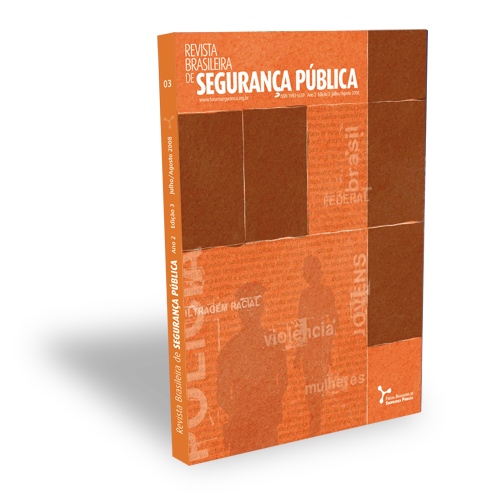Armed violence and its impacts on the civilian population:
a necessary burden?
DOI:
https://doi.org/10.31060/rbsp.2008.v2.n1.29Keywords:
Armed Violence, New forms of violence, Collateral effect, Impact on the civilian population.Abstract
The article addresses two types of contemporary violence: "armed conflicts" and "armed violence". In recent decades, ideas related to armed conflicts have been re-adapted as perceptions about the characteristics and nature of these conflicts have undergone substantial transformations. The collateral effects of such conflicts on people not directly involved is one of the factors that led to the institutionalization of International Humanitarian Law and the consolidation of the International Committee of the Red Cross. When one verifies that many of the causes and consequences of armed conflicts are also found in countries with armed violence - such as Brazil, South Africa and Jamaica - one realizes the possibility of drawing a parallel between both forms of contemporary violence. Moreover, the majority of firearm-related deaths do not occur in situations traditionally defined by armed conflicts: annual deaths related to armed conflicts amount to 30,000, according to estimates by Uppsala University, while violent deaths unrelated to armed conflicts would be between 200,000 and 270,000, according to the Small Arms Survey. Such figures challenge conventional categories of armed conflict and international humanitarian law, leading to the need to further analyze contemporary violence and promote the regulation of armed violence in order to control collateral effects and reduce the burden that is unnecessarily imposed on the civilian population.
Downloads
References
CCPDC – Carnegie Commission on Preventing Deadly Conflict. Preventing deadly conflict– Final Report. New York: Carnegie Corporation of New York, 1997.
DOWDNEY, Luke. Crianças do tráfico – um estudo de caso de crianças em violência armada organizada no Rio de Janeiro. Rio de Janeiro: 7 letras, 2003.
DOWDNEY, Luke. Nem guerra nem paz. Rio de Janeiro:7 letras, 2005.
DUARTE, Mário Sérgio de Brito; SILVA, Robson Rodrigues da; OLIVEIRA, João Batista Porto de; SILVA, Leonardo de Carvalho (Orgs.). Bala perdida. Rio de Janeiro: ISP, 2007.
GURR, Ted Robert. Peoples versus states: minorities at risk in the new century. Washington, D.C.: United States Institute of Peace Press, 2000.
HOLSTI, Kalevi. The state, war, and the State of War. Cambridge: Cambridge University Press, 1996.
HUMAN SECURITY AND CITIES PROJECT. Human security for an urban century: local challenges, global perspectives, 2007.
ICISS – International Commission on Intervention and State Sovereignty. (2001), Responsibility to protect– Research, bibliography, background.Canadá:Department of Foreign Affairs and International Trade, 2001.
INSTITUTO DE SEGURANÇA PÚBLICA. Resumo parcial do Estado do Rio de Janeiro – dezembro de 2007. Número referente ao título Auto de Resistência, acumulado de janeiro a dezembro de 2007.
KALDOR, Mary. New and old wars. Organized violence in a global era. Stanford: Stanford University Press, 1999.
LUND, Michael S. Operationalizing the lessons from recent experience in field level conflict prevention strategies. In: WIMMER, A. (ed.). Facing ethnic conflicts: toward a new realism. Lanham, MD, Rowman & Littlefield, 2004, p. 120-140.
MIALL, Hugh; RAMSBOTHAM, Oliver; WOODHOUSE, Tom Contemporary conflict resolution: the prevention, management and transformation of deadly conflicts. Cambridge [etc.], Polity, 2005.
O’BRIEN, Joseph V. World war II: combatants and casualties (1937-45). John Department of History. Jay College of Criminal Justice. 2007.
OECD-DAC. Guidance on armed violence reduction and development. Paris: OECD-DAC, no prelo.
PNUD – Programa das Nações Unidas para o Desenvolvimento. Human development report. 2002.
RAPLEY, John. The new middle ages. Foreign Affairs, v. 85, n. 3, p. 95-103, 2006.
SCHERRER, Christian P. Structural prevention of ethnic violence. Houndmills Palgrave Macmillan, 2002.
SMALL ARMS SURVEY. Rights at risk. 2004.
UNDP-WHO. Support for the development of a framework to address the impacts of armed violence on human security and development. Programme Document, PHASE I. The global armed violence prevention program, 2005.
UNIVERSIDADE DE UPPSALA. Uppsala conflict data program.
WALLENSTEEN, Peter; SOLLENBERG, Margareta. Armed conflict, 1989-2000. Journal of Peace Research, vol. 38, n. 5, 2001.
Downloads
Published
How to Cite
Issue
Section
License
Copyright (c) 2012 Revista Brasileira de Segurança Pública

This work is licensed under a Creative Commons Attribution 4.0 International License.
Licensing
The Brazilian Journal of Public Security uses the Creative Commons License as a form of licensing for its published works. The license used follows the CC BY 4.0 - Attribution 4.0 International model.
To see the permitted rights please go to the full licence or to our Copyright and Licensing page.



